Types of Appliances
W-ARCH | PALATAL EXPANDER | LOWER FIXED SCHWARTZ | ELASTICS | SPACERS | HEADGEAR | RETAINERS | HERBST

W-ARCH
The W-arch obviously got its name from its appearance. It is another form of expansion of the upper teeth. Unlike the RPE, it does not expand the whole upper arch but instead widens only the teeth in the arch form. The W-Arch is a non-removable appliance bonded to the permanent upper molars. It has been activated prior to placement and will expand at a gradual rate, requiring no help from the patient or parents.
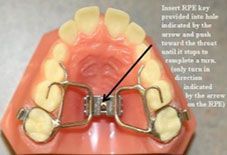
PALATAL EXPANDER
A palatal expander is used to widen the roof of the mouth in a patient with a narrow palate. It is a non-removable appliance bonded to the permanent molars. Using a special key, the patient and or parent is responsible for activating the RPE on a basis pre-determined by Dr. Montano. Activation requires turning the screw portion on the appliance with the key. This is usually done on a daily basis until the desired amount of turns has been achieved. Dr. Montano and his staff will instruct you on how many turns need to be made and show you step by step how to activate the expander.
The most common occurrence with the expander is opening space between the front teeth as the palate expands. This is only temporary and will be addressed once complete expansion has occurred. Occasionally, there may be pressure in the sinus area for a few days. Food can get stuck between the palate and the appliance, making brushing and rinsing after every meal necessary. During the first few days after placement, you may notice a change in speech or excessive saliva; these are normal and temporary and will lessen the more you talk. As with anything new, it takes time to get used to it. If you miss a turn, continue with only one turn per day until all turns have been completed. Never double up on turns! If the appliance ever feels loose, do not continue with any additional turns and contact the office as soon as possible.
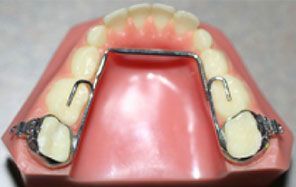
LOWER FIXED SCHWARTZ
This appliance is bonded to the lower permanent molars and incorporates a wire with a spring that runs behind the lower front teeth. The lower fixed Schwartz is used to expand the teeth in the lower arch by consistent gradual force.

ELASTICS
One of the most popular questions asked is, “Will I have to wear rubber bands?” The short answer is, “Yes.” There are very few patients that go the entire course of treatment without having to wear elastics/rubber bands at some point. Orthodontic elastics correct improper bites. A pulling force is applied to the teeth when elastics are worn, working the dental arches against one another to create the desired outcome. There are numerous ways to wear elastics, depending on your specific bite, but it generally involves connecting the top and bottom arches. Once Dr. Montano has determined what classification of bite you have, he will prescribe the necessary type of elastics. The goal of elastic wear is to achieve a proper Class I bite, where all of the teeth occlude properly and there is not an excessive overbite or underbite.
Patient compliance is very important to the success of elastics. Unless directed otherwise, elastics should be worn 24 hours a day. Take them out to eat and brush, and place new ones at least twice a day, usually in the morning and at night. If you run out of or loose your elastics, you may call the office and we can mail you a new bag. If you are ever uncertain of how to wear the elastics or have specific concerns, stop wearing the elastics and call the office for a check appointment. Wearing your elastics the wrong way can cause delays in finishing your treatment!
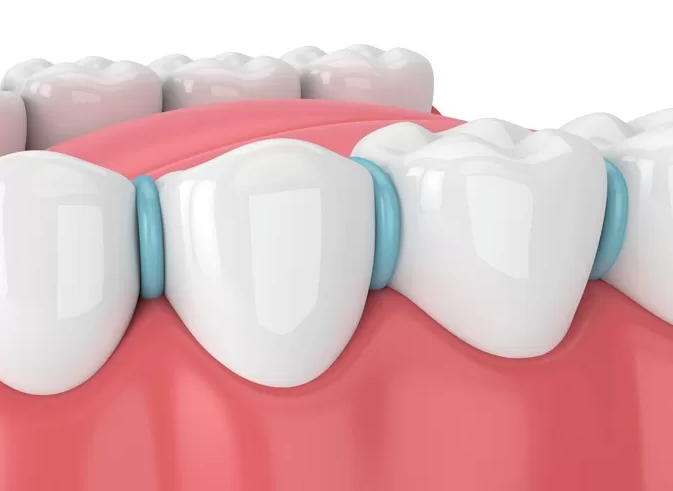
SPACERS
Separators, or “spacers”, are small metal or rubber rings that are placed between the teeth approximately one week before a band is cemented. A separator creates a small space between two adjacent teeth to allow the band to slip over the tooth. Once adequate space has been made and the band is ready to be cemented in, the separator will be removed. While the separator is in place, flossing of the area or eating sticky, chewy foods should be avoided. These actions can dislodge the separator, making it impossible to place a band on the tooth. If a separator falls out more than a day or two before your appointment, please call the office to have it replaced.
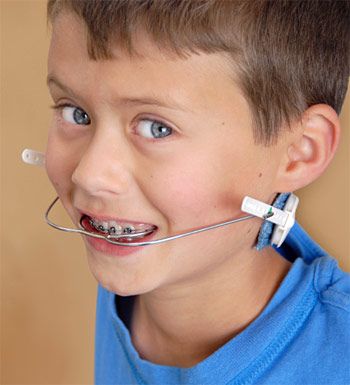
HEADGEAR
Headgear is a removable orthopedic device generally used in adolescent patients during times of growth to treat discrepancies of growth in the upper or lower jaws. It is made up of two parts: a facebow and strap. The facebow is the portion that goes into the mouth and is inserted into the tube holes on the molar bands. There are several different types:
- Cervical
- High pull
- Reverse pull
Cervical and high pull headgear utilize a pushing force to hold the upper jaw back and allow for growth of the lower jaw, thus eliminating severe overbites. The reverse-pull appliance applies a pulling force/protraction directing growth of the upper jaw forward to correct underbites. In order to be effective, headgear requires a minimum 10-14 hours of consistent wear. However, a good rule of thumb to follow is to wear it anytime you are at home, including sitting and watching TV, after dinner, and at night while sleeping. Always make sure the headgear is being worn properly as per the doctor’s instructions. If headgear has been prescribed for you or your child, it should be brought to every appointment to ensure it fits and is being worn properly.

INVISIBLE RETAINER
The invisible retainers are made of a clear plastic material that has been heated and molded over your teeth on the molds taken after the braces have been removed. These can also be used for whitening trays.
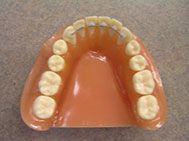
BONDED "PERMANENT" RETAINERS
The bonded “permanent” retainer can be used on one or both arches. It is most generally bonded to the tongue side of the front teeth. This type of retainer is especially helpful in a case of severely crooked or crowded teeth, or to keep large gaps from opening back up.

"TRADITIONAL" HAWLEY RETAINERS
The “Traditional” Hawley retainer is made of rigid acrylic and wire. The acrylic rests on the roof of the mouth or under the tongue while the wire wraps around the teeth to hold them in proper alignment. Hawley retainers are best utilized in cases where teeth have been extracted and the space needs to be held closed, or when teeth are missing and the space must be kept open for future restorative work.
Contrary to popular belief, one is not necessarily better than the other. All retainers, when worn properly, are adequate at keeping the teeth straight. Once the braces have been removed and after reviewing your treatment plan Dr. Montano will decide which retainers will be best for you.
CARING FOR YOUR RETAINERS
With the exception of the bonded retainer, retainers should be kept in their case in a cool, dry place when not in your mouth. Never wrap them in Kleenex or a napkin, this is a sure way to lose them or throw them in the trash. Dogs and cats love to eat them too. Keep them away from direct sunlight or heat, as this will warp them. Always remove retainers to eat, drink, and brush your teeth before placing them back in your mouth.
Retainers should be removed with two hands, gently teasing on each side-starting in the back and then moving toward the front until they come out. Note: removing from one side with one hand can result in the retainers cracking. We recommend wearing your retainers while sleeping. Clear retainers are heat-sensitive; they should be brushed with cold water, toothbrush, and antibacterial liquid detergent (like Dial or Dawn). Never use toothpaste, hot water, mouthwashes, or peroxides to clean; denture-safe cleaners are OK. If a bonded retainer has been placed you must take special care to brush around it and use a floss threader to gain proper access in between the teeth.
LOST OR BROKEN RETAINERS
If there is ever a question of how a retainer is fitting or if you suspect that it is lost or broken, call the office immediately. We will need to make an appointment to replace or repair the retainer(s). If possible, locate the retainer and bring it with you. If it is broken bring all of the pieces in, since it may be able to be repaired. In some cases adjustments can be made at the same appointment. Prompt action can prevent any shifting and help maintain a beautiful smile. A replacement or repair fee may apply.

HERBST
The Herbst is a bonded non-removable orthopedic device that is used to correct severe overjet/overbite, or deep bites. This appliance is predominantly used in adolescent patients because it requires active growth to be successful. The Herbst facilitates the growth of the lower jaw in a forward direction by positioning it forward and holding it there. It also simultaneously applies pressure to the upper jaw in a backwards direction.
Bands are bonded to the upper and lower molars on either side of the mouth and connected from top to bottom by telescoping arms. These arms are screwed to the bands by small screws with an Allen Wrench. These arms will not interfere with normal opening and closing of the mouth for talking or eating. In general, it is a good idea to cut up all of your food into small bites to aid in the chewing process for the first few days. Until your cheeks become accustomed to the appliance you may develop areas of irritation. You can use wax to smooth any uncomfortable areas, and sleeping on your back at night instead of your side may prove to be more comfortable. If tenderness in your teeth or muscles of the cheeks becomes a problem, Tylenol® or a similar pain reliever should provide relief. If the appliance ever becomes loose or a screw falls out, save any parts and call the office as soon as possible. We will provide you with an Allen wrench so that any loose screws can be tightened from the convenience of home. Normally, the Herbst is worn for approximately 9 to 12 months to take advantage of individual growth for optimal results.

